Physical Address
304 North Cardinal St.
Dorchester Center, MA 02124
Musculoskeletal symptoms are a major cause of pain and disability, accounting for a quarter of all general practitioner consultations in the United Kingdom (UK), with significant economic consequences. Common musculoskeletal conditions, such as back pain and osteoarthritis, are the dominant causes of chronic pain, disability and work loss in the UK and many other countries, consuming considerable health and social service resources. In addition, inflammatory arthritis and connective tissue disorders may present with musculoskeletal symptoms. As such, it is critical that clinicians are able to assess patients with such symptoms and initiate appropriate management or referral to a specialist centre. Early diagnosis and treatment of inflammatory arthritis, such as rheumatoid arthritis, has been consistently shown to improve patients’ long-term outcome with the early initiation of disease-modifying therapy. The autoimmune rheumatic disorders, although much less common, cause significant morbidity with the potential for end-organ damage which may be fatal if not recognized and treated early.
The objectives of performing a musculoskeletal assessment are to:
Make an accurate diagnosis
Assess the severity and consequences of the condition
Construct a clear management plan
Taking an effective structured history and making a simple, focused examination are likely to be more important than imaging and serology, which on their own may be falsely reassuring. Although modern musculoskeletal medicine uses complex imaging and immunological investigations, in most patients with locomotor disorders, diagnosis can be achieved at the bedside without complex investigations.
This brief screening examination, which should take 1 to 2 minutes, has been devised for use in routine clinical assessment. This brief global assessment of the gait, arms, legs and spine (GALS) is typically used by both non-specialist and specialist alike ( Box 15.1 ). The routine requires some practise to become proficient, but once achieved, it has been shown to be highly sensitive in detecting significant abnormalities of the musculoskeletal system. It involves inspecting carefully for joint swelling and abnormal posture, as well as assessing the joints for normal movement. Typically, the clinician will then focus on particular areas of interest with more dedicated and targeted examinations.
Observe gait
Observe patient in anatomical position
Observe movement: hands behind head
Observe backs of hands and wrists
Observe palms
Assess power grip and strength
Assess fine precision pinch
Squeeze metacarpophalangeal joints (MCPJs)
Assess full flexion and extension
Assess internal rotation of hips
Perform patellar tap
Inspect feet
Squeeze metatarsophalangeal joints (MTPJs)
Inspect spine
Assess lateral flexion of neck
Assess lumbar spine movement
If answers to the following four questions are negative, a musculoskeletal disorder is unlikely:
Do you have any pain or stiffness in your muscles, joints or back?
Have you ever had gout or arthritis?
Can you dress yourself completely without difficulty?
Can you walk up and down stairs without difficulty?
Positive answers imply the need for a more detailed assessment, as will be described in this chapter.
Watch the patient walking and turning back towards you. Normal: symmetry, smooth movement, arm swing, no pelvic tilt, normal stride length, ability to turn quickly.
With the patient standing in the anatomical position, observe from behind, from the side and from in front. Muscle symmetry should be noted along with limb alignment. Spine and limb alignment can be observed as well as abnormalities in the feet, such as pes planus or pes cavus.
Common gait abnormalities are listed in Table 15.1 .
| Type | Description | Causes |
|---|---|---|
| Antalgic | Avoiding weight bearing on affected side | Pain related to arthritis or tendonitis |
| Spastic | Leg swings outwardly from hip with extended knee | Hemiplegia related to stroke |
| Shuffling | Small shuffling steps, speeding up (festination), reduced arm swing and difficulty turning | Parkinson’s disease |
| Ataxic | Wide-based gait, swaying torso | Cerebellar disease. Peripheral sensory ataxia (typically worsens with loss of visual input) |
| Waddling (Trendelenburg) | Exaggerated lateral movement of trunk and circumduction of hip to compensate for weak abductors | Bilateral gluteus medius tendinopathy |
| High stepping (foot drop) | Excessive hip and knee flexion to accommodate failure of ankle dorsiflexion | Peroneal neuropathy (multiple causes) |
Inspect the standing patient. Normal on inspection: no scoliosis, symmetrical paraspinals, normal shoulder and gluteal muscle bulk and symmetry, level iliac crests, normal cervical and lumbar lordosis. Movement: finger to floor distance less than 15 cm, lumbar expansion greater than 6 cm, ear touches acromion.
From behind: look for abnormal spinal and paraspinal anatomy and look at the legs.
From the side: look for abnormal spinal posture, then ask the patient to bend down and touch his toes ( Fig. 15.1 ).
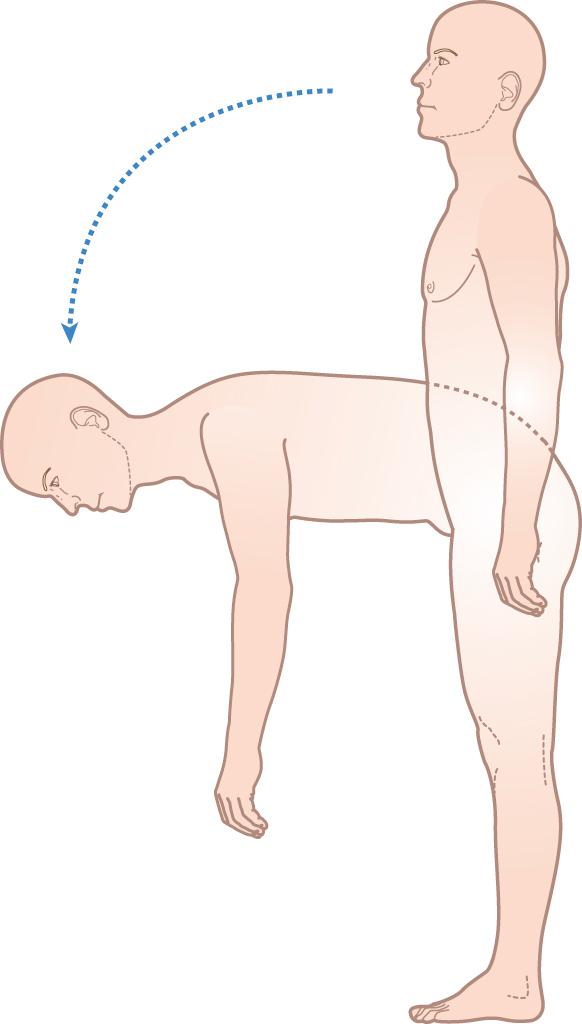
From the front: ask the patient to ‘put your ear on your left then right shoulder’ and watch the neck movements ( Fig. 15.2 ).
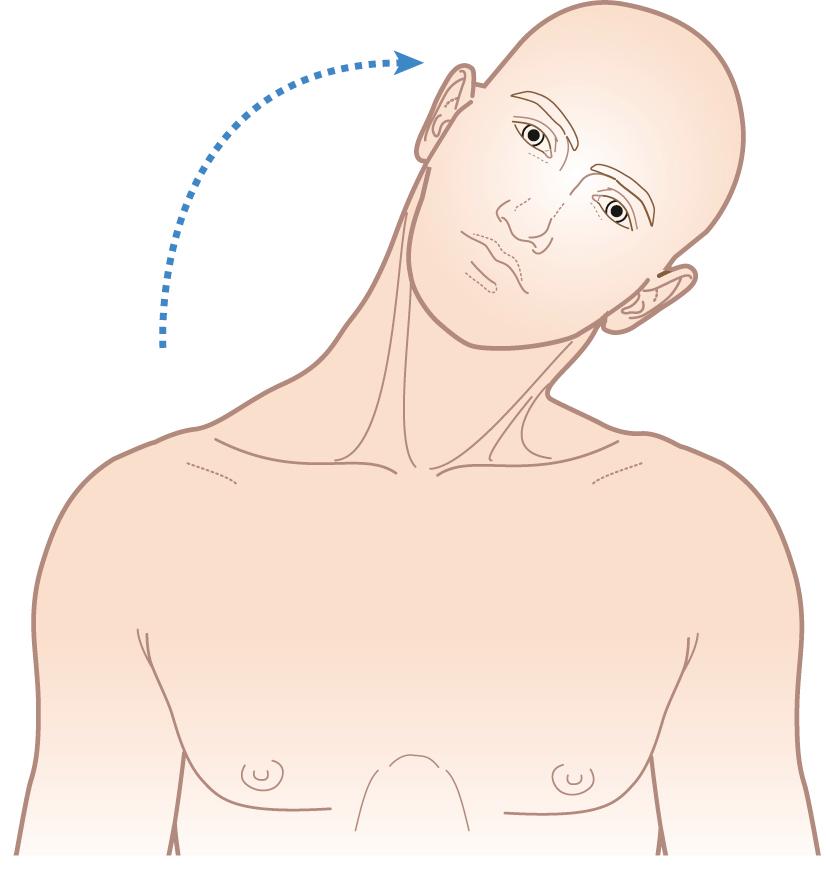
Gently press the mid-point of each supraspinatus muscle to elicit tenderness ( Fig. 15.3 ).
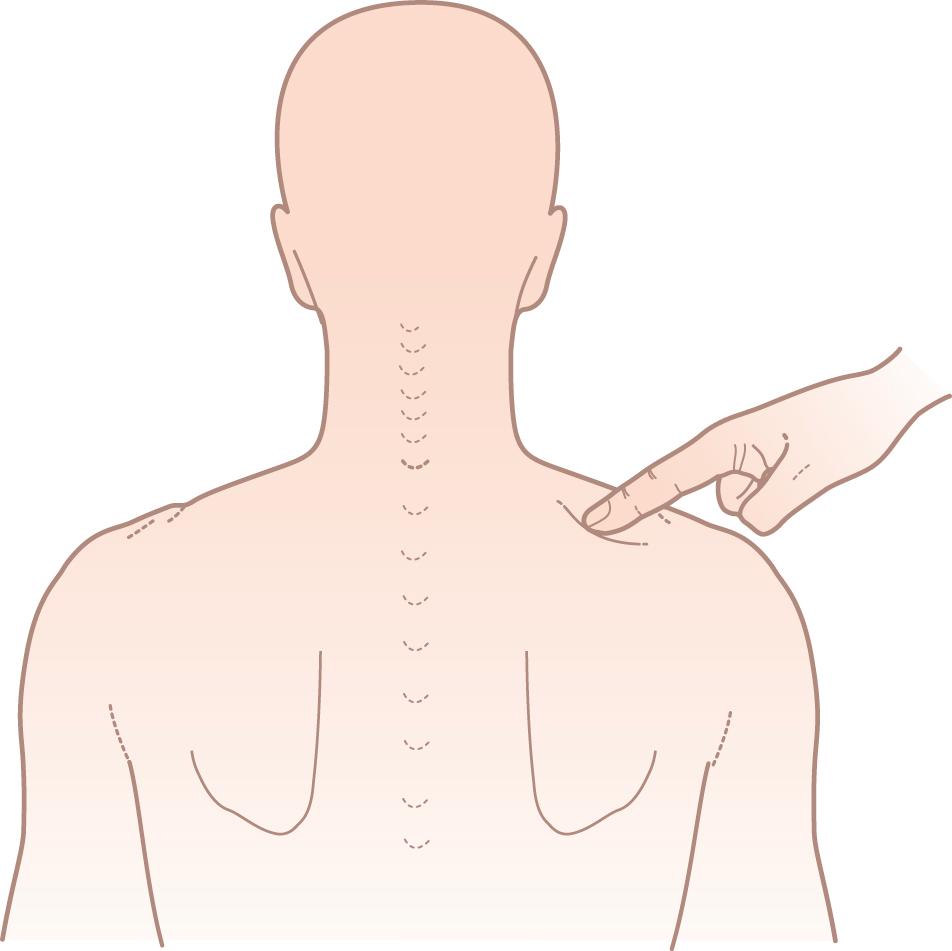
Ask the patient to follow instructions as in Table 15.2 (see Figs 15.4–15.9 ).
| Instruction | Normal outcome |
|---|---|
| ‘Raise arms out sideways and up above your head’. | 180° elevation through abduction without wincing |
| ‘Touch the middle of your back’. | Touches above T10 with both hands |
| ‘Straighten your elbows right out’ | Elbows extend to 180° or slightly beyond (females) symmetrically |
| ‘Place hands together as if to pray, with elbows right out’. | 90° wrist extension and straight fingers |
| ‘The same with hands back to back’. | 90° wrist flexion |
| ‘Place both hands out in front, palms down, fingers out straight’. | No wrist/finger swelling/deformity, 90° pronation |
| Metacarpophalangeal (MCP) cross-compression | No tenderness |
| ‘Turn hands over’ | 90° supination No palmar swellings, wasting or erythema |
| ‘Make a fist and hide your nails’. | Can hide fingernails |
| ‘Pinch index, middle finger and thumb together’ | Can do |
| Also look for swelling between the heads of the metacarpals and gently squeeze across the MCP joints to elicit tenderness. | Tenderness may be elicited |
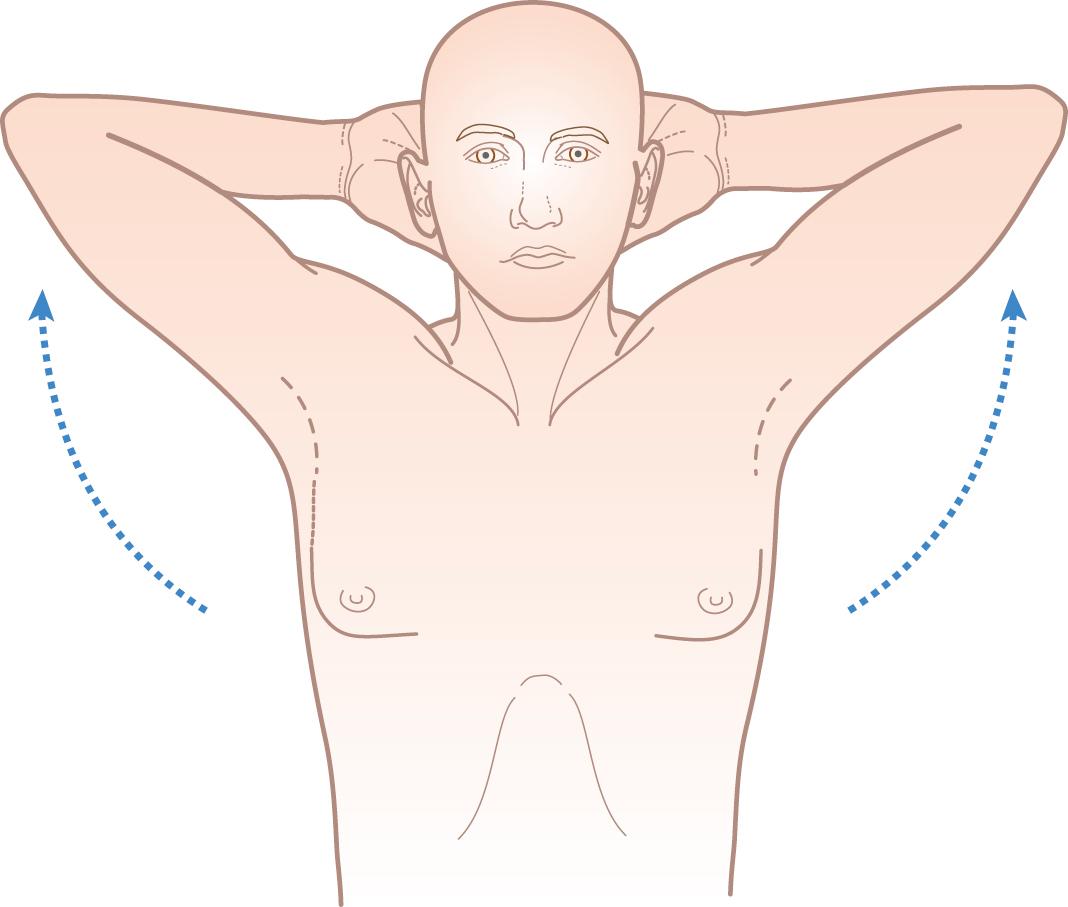
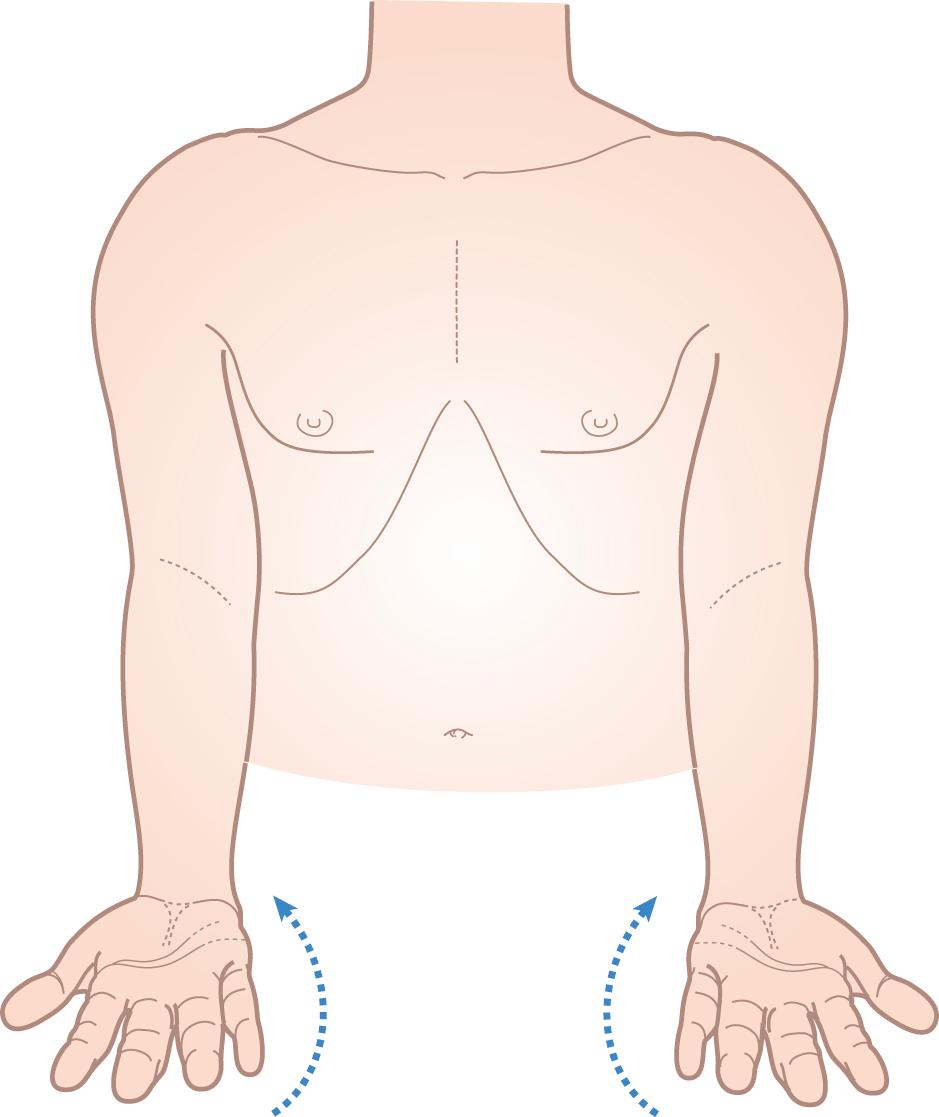
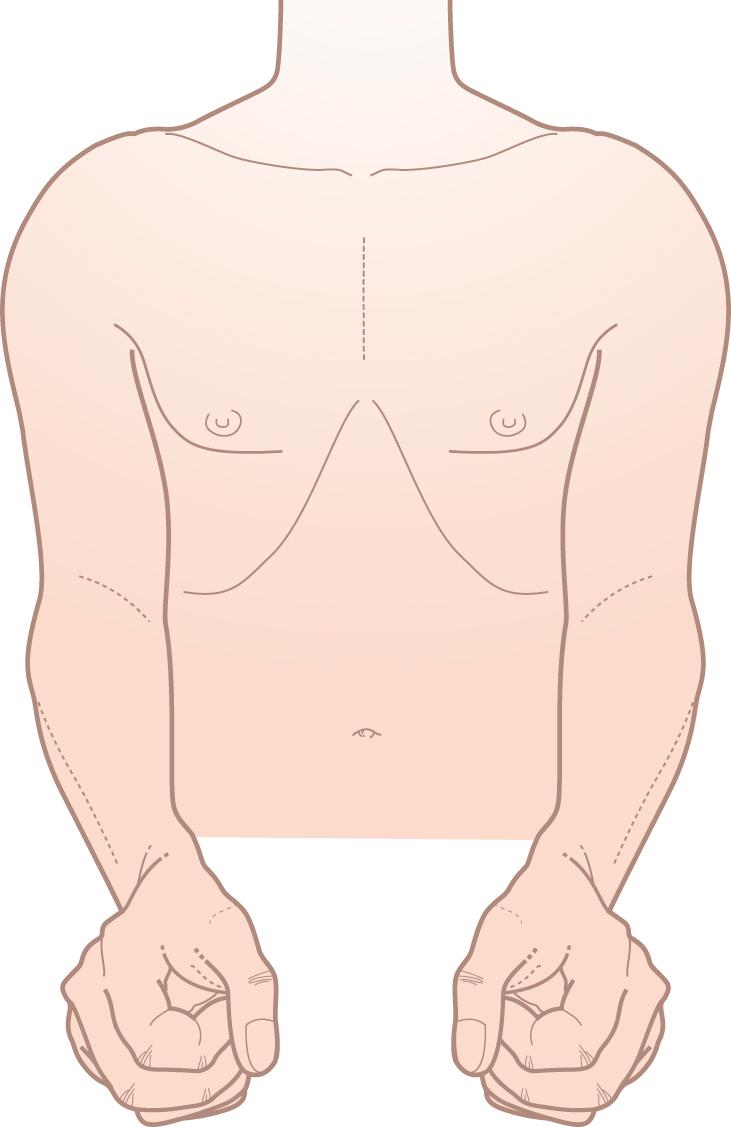
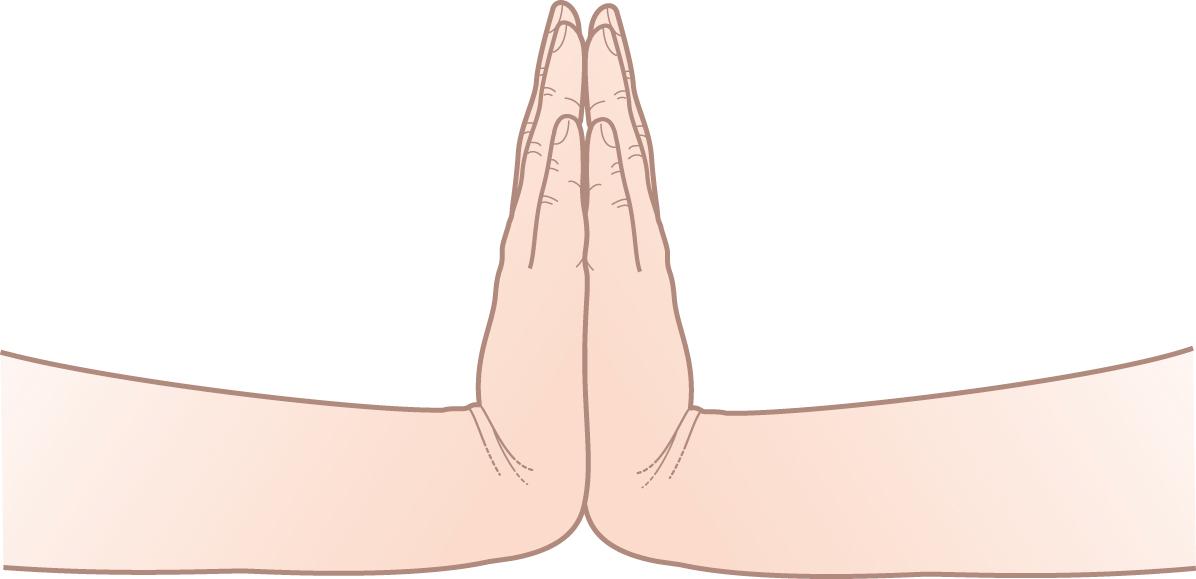
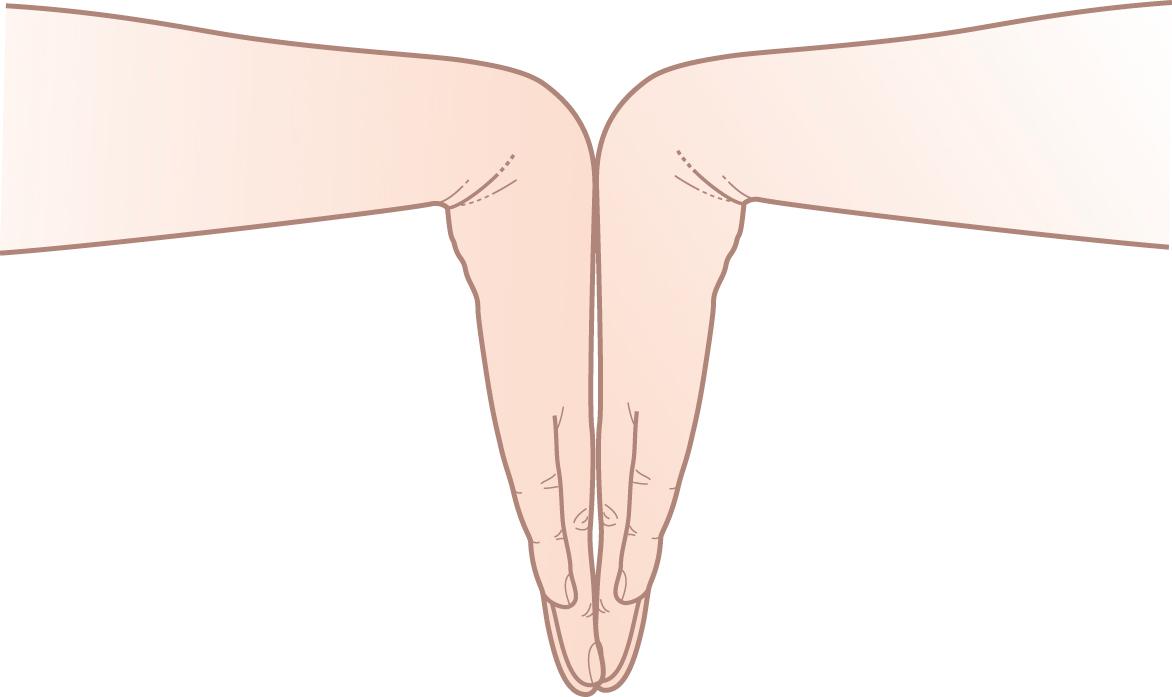
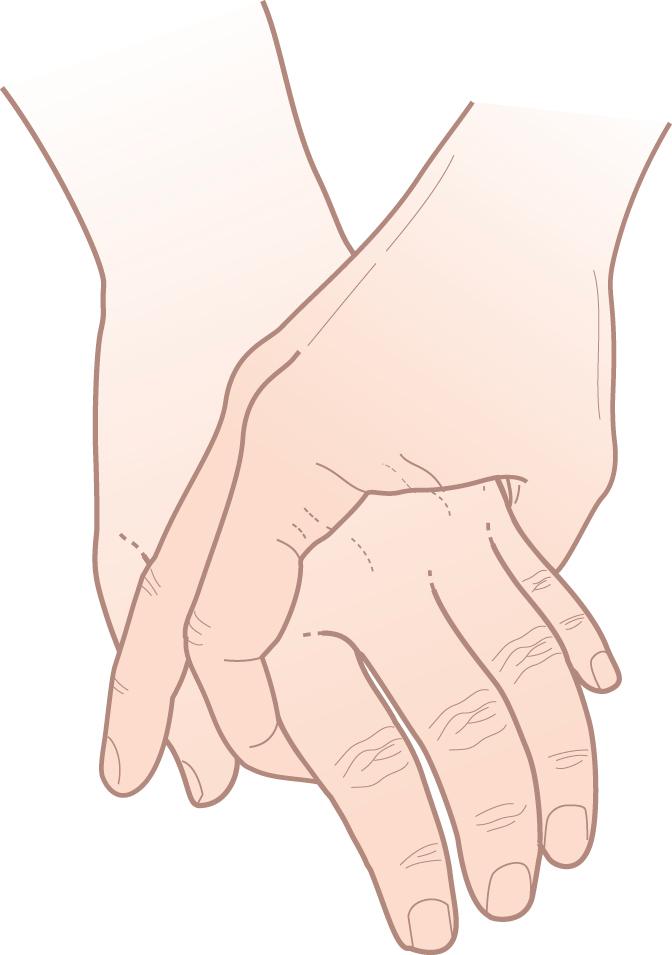
With the patient still standing:
Examine the lower limbs for swelling, deformities or limb shortening. Normal: no knee deformity, anterior or popliteal swelling, no muscle wasting, no hindfoot swelling or deformity.
Then, with the patient lying on a couch, continue the examination following the instructions in Table 15.3 (see Figs 15.10–15.14 ).
| Instruction | Normal outcome |
|---|---|
| Flex hip and knee, holding knee | No bony crepitus, 140° knee flexion |
| Passively rotate hips | 90° total pain-free rotation |
| Bulge test/patellar tap | No detectable fluid |
| Palpate popliteal fossa | No swelling |
| Inspect feet | No deformity, callosities or forefoot widening (daylight sign) |
| Test subtalar and ankle movement | Pain-free calcaneal mobility at subtalar joint, dorsiflexion beyond plantigrade and 30° plantarflexion |
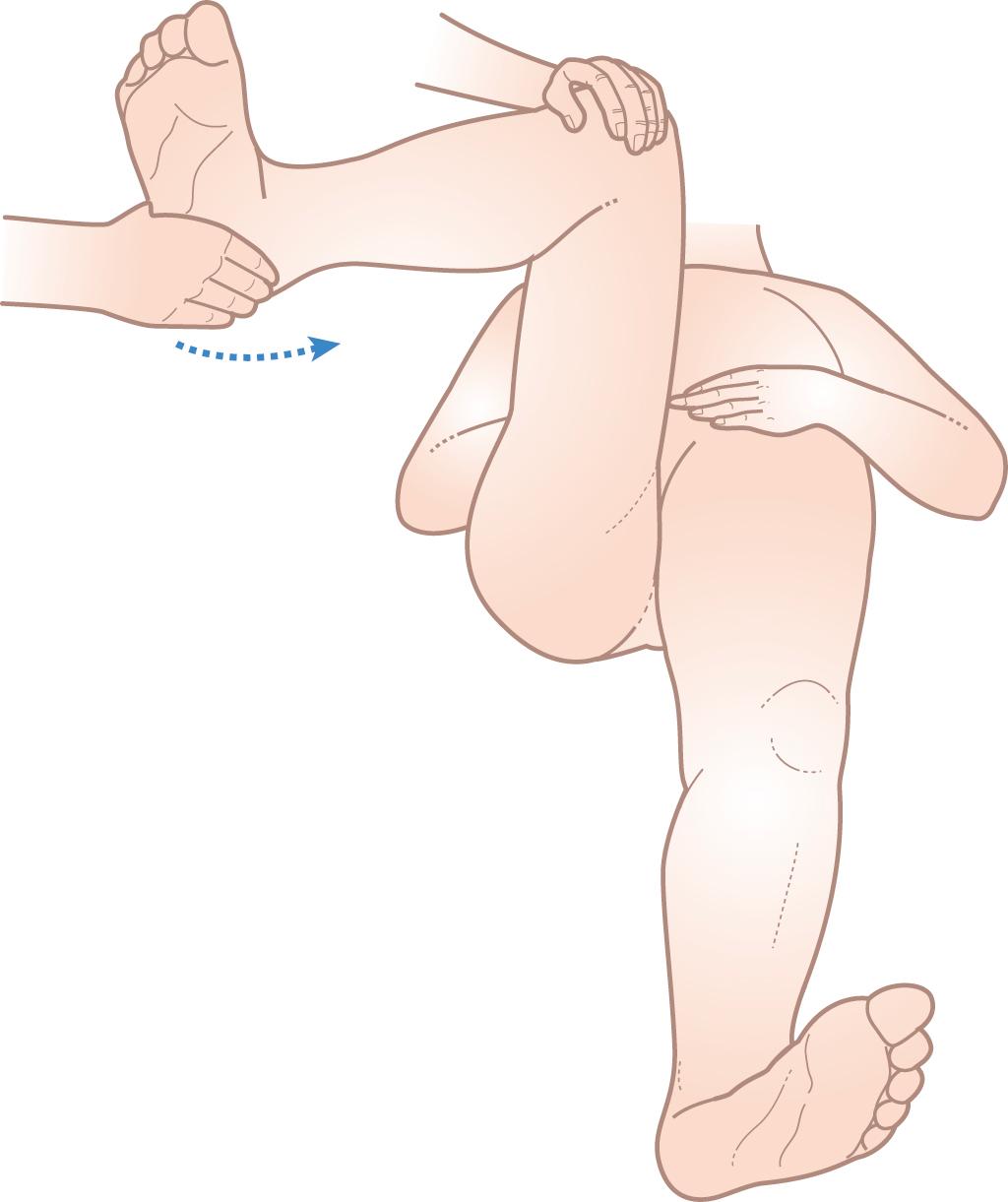
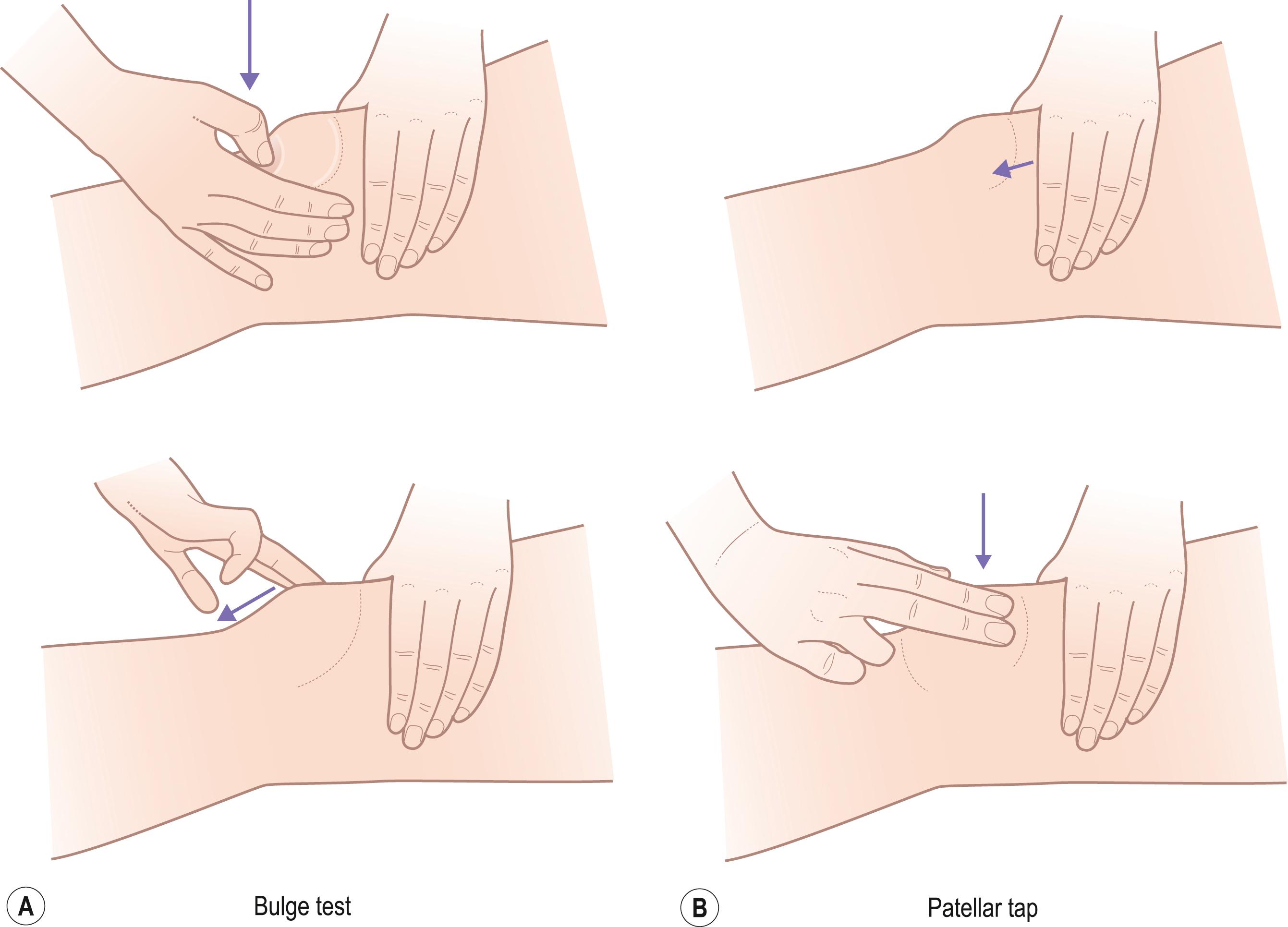
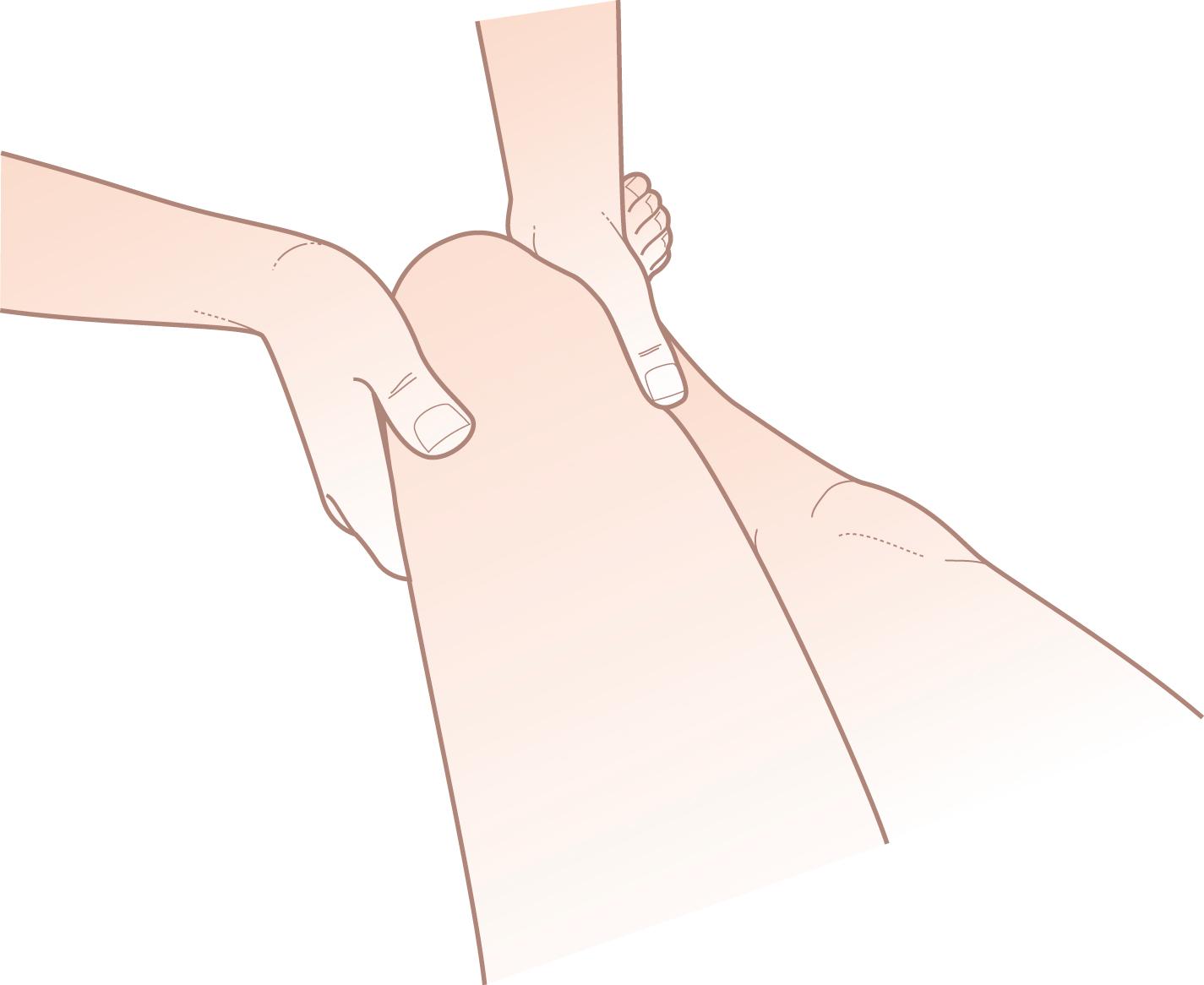
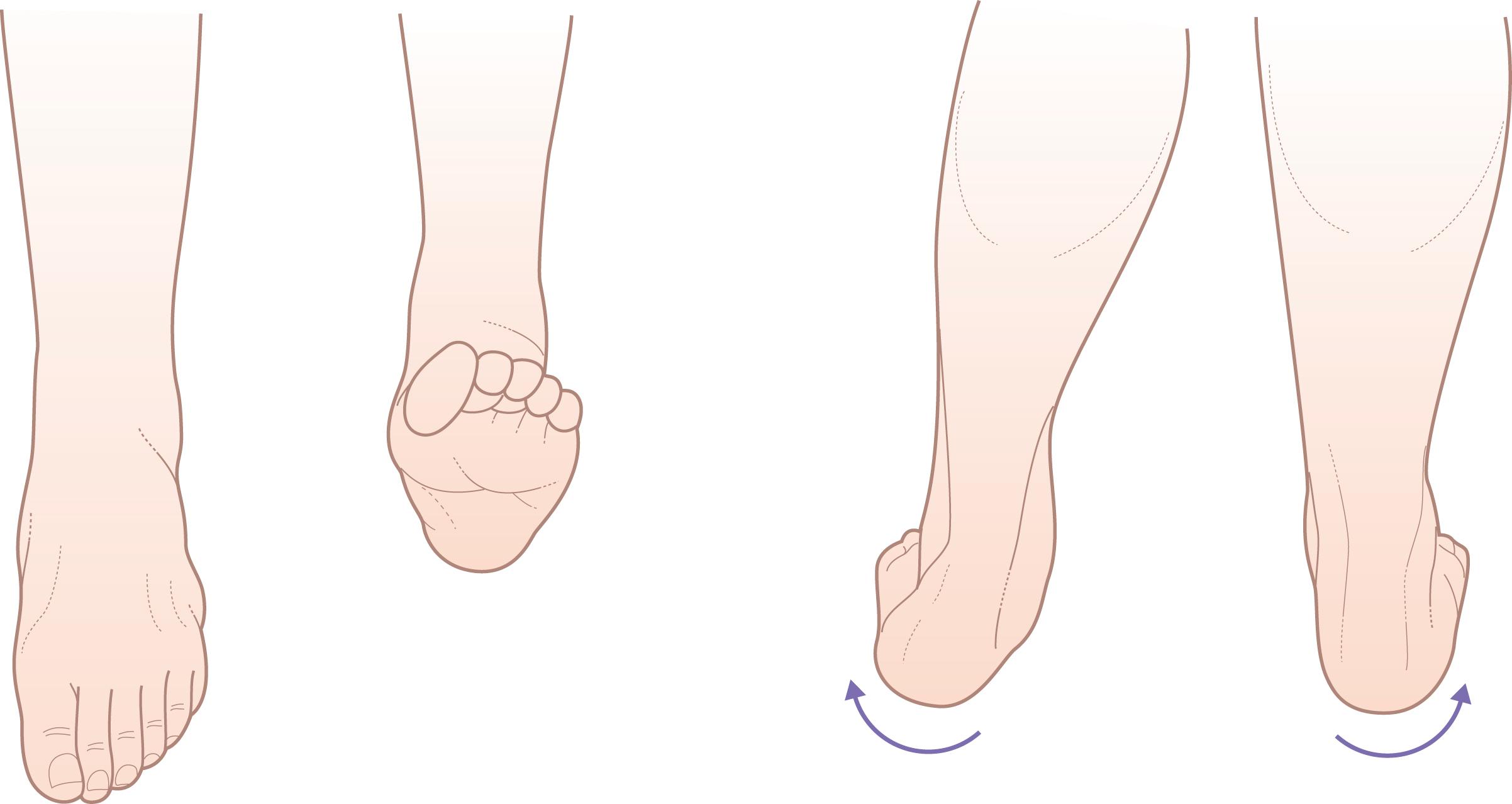
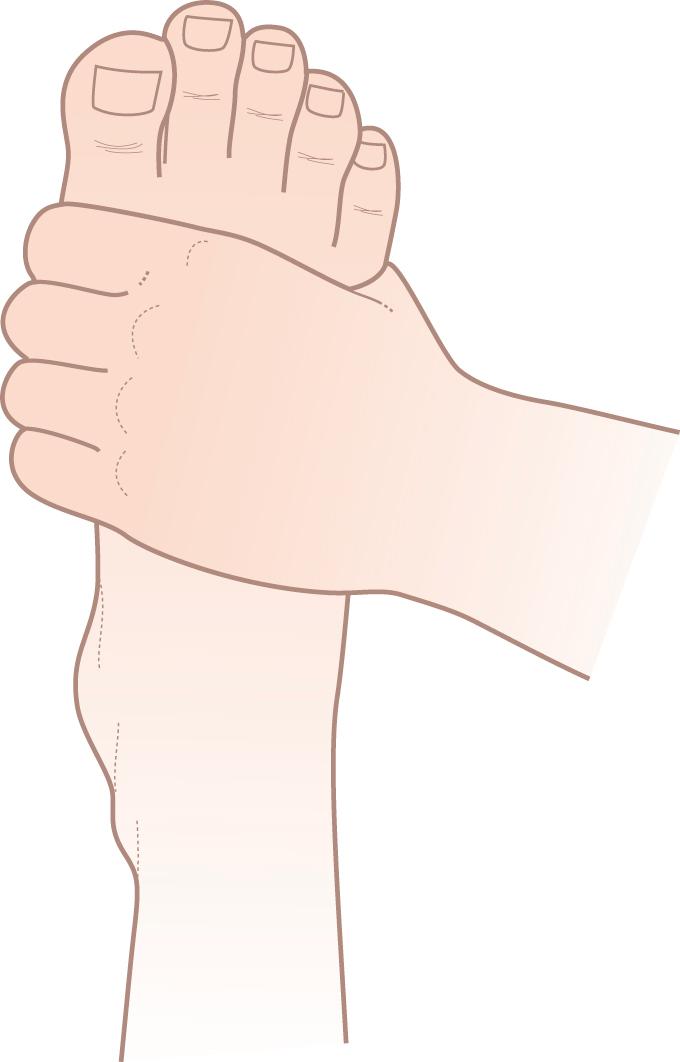
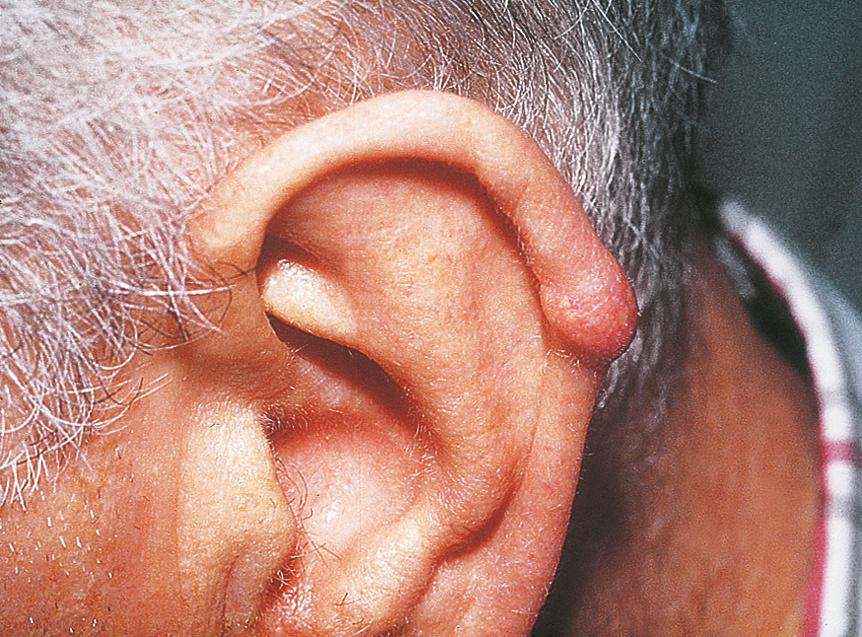
This examination can be conducted in approximately 2 minutes, especially if the clinician performs the movements and asks the patient to follow them. The precise order of the examination is not important, and clinicians usually develop their own pattern of examination.
Children should have their height and weight measured and plotted on centile charts to assess growth. When examining children, the assessment of the musculoskeletal system should be done with a parent present and include all the components of the adult version, with minor additions as follows:
Ask the child to walk on his tiptoes and then on the heels.
From the front, ask the child to put his hands together (as if praying) and also put his hands back to back and then have him reach his arms up towards the sky.
Additionally, when assessing the spine, ask the child to open his mouth and insert three of his own fingers into it.
Symmetry is key and any asymmetry should be assessed for pathology. It is normal for toddlers to be ‘bow-legged,’ ‘knock-kneed’ and ‘flat-footed’. Various foot and toe appearances are also normal, including in-toeing, out-toeing and ‘curly’ toes. These appearances usually resolve as the child grows.
The incorporation of a brief musculoskeletal examination into the routine examination should lead to a more detailed assessment if any abnormalities are found ( Table 15.4 ).
| Screening issues: | Pain | 0 | |
| Gout or arthritis | 0 | ||
| Dressing | ✓ | ||
| Walking | ✓ | ||
| with positive answers being elaborated. | |||
| Examination: | |||
| A (Appearance) | M (Movement) | ||
| G | ✓ | ||
| A | ✓ | ✓ | |
| L | ✓ | ✓ | |
| S | ✓ | ✓ | |
| with abnormal findings indicated, e.g. in rheumatoid arthritis: | |||
| A (Appearance) | M (Movement) | ||
| G | ✗ | ||
| A | ✗ | ✗ | |
| L | ✗ | ✗ | |
| S | ✓ | ✓ | |
| Slow painful gait. | |||
| Synovitis of metacarpophalangeal (MCP), metatarsophalangeal (MTP), wrists and knee joints. | |||
General demographic details, such as age, sex and occupation, should be recorded. Start the full musculoskeletal history with the presenting complaint and ask the patient to describe the sequence of symptoms, related features and events since the onset. Characteristic diagnostic points may emerge. Pain is a common presenting complaint and, as such, the clinician is expected to explore this fully. Using the WILDA ( W ords, I ntensity, L ocation, D uration, A ggravating/alleviating factors) pain assessment approach may be helpful in drawing out key aspects of the patient’s history and clarifying the nature of the complaint (see also Chapter 11 ).
‘I have pain’ is not descriptive enough to inform a clinician about the character of the pain symptoms. Patients may have more than one type of pain and should be encouraged to describe their pain as much as possible. Neuropathic pain can be described as burning, shooting, tingling, radiating, lancinating or numbness. Somatic pain may be described as dull or throbbing and can usually be well localized. Somatic pain is most commonly described in the context of musculoskeletal pain afflicting joints and the spine.
Pain described as squeezing, pressure, cramping, distention, dull, deep and stretching is visceral in origin.
It may be useful to use a simple visual analogue scale or ask the patient to rate his pain on a 0 to 10 scale. This may allow for monitoring and assessing progression of the underlying disorder.
An accurate location of pain is often very helpful, although it must be remembered that joint pain may radiate. Patients should be asked, ‘Where is your pain?’ or ‘Do you have pain in more than one area?’
Pain may be referred or radiate from an affected joint ( Box 15.2 ).
Pain may be referred or radiate from an affected joint, e.g.:
Neck pain may radiate through the occiput to the vertex or to the shoulder and down the arm, with paraesthesiae if there is nerve-root impingement.
Shoulder joint pain may radiate to the elbow and below.
Thoracic spine nerve root pain may radiate around the chest and mimic cardiac pain.
Lumbar spinal root pain may radiate through the buttock and leg to the knee and below, with paraesthesiae in the foot with a large disc prolapse; this is called ‘sciatica’.
Hip-joint pain may radiate to the knee and below.
Knee pain may radiate above and below the joint.
The temporal description of pain is important in understanding the root cause. Pain may be constant, episodic or a combination of both. Is the patient ever pain free? Can he clearly identify the time of onset and is there a pattern of periodicity? For example, an osteoporotic vertebral fracture may be acute and self-limiting, which contrasts with the severe, constant and gnawing pain of a spinal metastatic deposit that prevents sleep.
Aggravating and alleviating factors are often very helpful when trying to make a diagnosis. Back pain or stiffness that improves with exercise may point to an inflammatory cause, whereas pain that worsens after use is often described in the setting of degenerative arthritis.
Back pain is the most common musculoskeletal complaint; as such, it deserves further consideration. When taking a history of a patient’s back symptoms it is important to identify potential ‘red flags,’ which mandate further imaging or investigations, to exclude a potentially sinister underlying diagnosis. If red flag signs are present, then referral to a specialist for further evaluation is advised and a patient should be advised to rest and to avoid physical activity until then. Importantly, nerve root pain (unilateral sciatica) is not itself a cause for alarm, and conservative treatment should be effective. A list of red flag symptoms associated with back pain can be found in Table 15.5 , with potential associated causes.
| Red flag | Potential cause |
|---|---|
| Elderly (>65 years) or young (<40 years) patient | Elderly patient: osteoporosis Young patient: inflammatory arthritis |
| Immunocompromised | Infection |
| Trauma | Fracture or displacement |
| History of cancer | Malignancy/metastasis |
| Nocturnal pain | Malignancy |
| Systemically unwell (temperature/weight loss/night sweats) | Infection |
| Thoracic pain | Inflammatory: ankylosing spondylitis Infection/malignancy Aortic dissection/pancreatitis |
| Saddle anaesthesia/bilateral sciatica/progressive neurological deficit | Cauda equina or cord compression |
| Bladder, bowel or sexual dysfunction | Cauda equina or cord compression |
Pain may be referred or radiate from an affected joint (see Box 15.2 ). With these pain patterns in mind, the joints above and below the apparently affected area should be examined.
Chronic pain syndromes need to be distinguished from other rheumatic disorders and a careful history is essential. A number of pain descriptors used by patients can indicate the influence of non-organic amplifying factors. For example, at least in the English language, words like ‘searing,’ ‘torturing’ and ‘terrifying’ can be used by patients with chronic widespread pain and fibromyalgia. Fibromyalgia falls under an umbrella term—Central Sensitization Syndromes (CSS) and so may present with overlapping symptoms with other conditions such as irritable bowel syndrome, chronic fatigue and temporo-mandibular joint (TMJ) disorders. These debilitating disorders are often accompanied by poor sleep patterns, severe fatigue and depressed mood. The difficulty of cultural, religious and linguistic influences in interpreting pain should not be underestimated.
A combination of pain and stiffness, leading to loss of function, is a classic feature of joint disease. Usually one component predominates, as with stiffness in inflammation and pain in mechanical joint problems. Therefore, specific questions will establish whether symptoms are non-inflammatory (e.g. osteoarthritis) or inflammatory (e.g. rheumatoid arthritis). As with any condition, the good clinician will also draw out the consequences of the disorder in terms of the impact on the patient’s day-to-day function and quality of life. The effect on relationships, work and social activities will help the clinician to gauge the severity of the problem and possibly elicit issues of stress and psychosocial pressure.
Pain of a non-inflammatory origin is more directly related to function and use and usually is relieved with rest. This is in contrast to inflammatory joint pain, which is often present at rest as well as in use, and tends to vary from day to day and from week to week. Stiffness, particularly in the morning or after a period of inactivity, is often a feature in the history of inflammatory joint pain and typically lasts no more than 30 minutes. However, in severe cases the duration may be much longer. Subjective joint swelling may be described and indeed patients with knee osteoarthritis may present with a significant effusion. Joint swelling in this context tends to be more intermittent than the persistent joint swelling and warmth seen in inflammatory conditions.
Locking of a joint may occur. In the knee, this means that the knee becomes locked in such a way that it will not extend fully, although it may flex. In other joints, locking is less well defined and simply means that at some point through its range of motion the joint becomes stuck, usually associated with pain and often followed by swelling. Locking is caused by material within the joint interfering with movement at the articular surfaces. In the knee, this is usually part of one of the menisci or a cartilaginous loose body.
Early morning joint stiffness that persists for more than 30 minutes is an important symptom of active inflammatory joint disease. Ask about redness (rubor), warmth (calor), tenderness/pain (dolor) and swelling (tumour), the classic features of inflammation.
The pattern of joint involvement is important. Common patterns are monoarticular (single joint), pauciarticular (up to four joints), polyarticular (many joints) and axial (spinal involvement). The pattern of joint involvement often aids in making a list of likely differential diagnoses. For example, rheumatoid arthritis is typically a symmetrical inflammatory arthritis of the small and large joints, often presenting with metacarpophalangeal (MCP), wrist and metatarsophalangeal (MTP) joint involvement. There are only a few causes of an exactly symmetrical arthropathy ( Box 15.3 ). An asymmetrical inflammatory arthritis presentation is often seen in spondyloarthropathies, such as reactive arthritis. An inflammatory monoarthritis presentation must arouse a suspicion of infection alongside other potential conditions, such as gout or psoriatic arthritis. A history of fever or sweating may be helpful and, if possible, synovial fluid should be aspirated from the joint to look for an infection. Monoarthritis will certainly raise the suspicion of an infected joint, but may also be seen in the context of crystal arthropathies and spondyloarthropathies, particularly psoriatic arthritis in which the knee or elbow is often singularly affected. Other conditions have such a classic history that it is almost diagnostic. For example, acute inflammation in the first metatarsophalangeal joint (hallux) suggests a diagnosis of gout ( Box 15.4 ). The pain and stiffness of the shoulder and hip girdles in polymyalgia rheumatica is also typical ( Box 15.5 ). The pattern of the spondyloarthropathies can also be diagnostic with inflammatory sacroiliac and spinal pain and stiffness, lower limb arthritis, Achilles tendinitis and plantar fasciitis.
Upper and lower limbs: rheumatoid arthritis, systemic lupus erythematosus
Especially upper limbs: haemochromatosis (hand: index, middle metacarpophalangeal joints)
Psoriatic arthritis
Spondyloarthritis (e.g. ankylosing spondylitis, reactive arthritis)
Document any associated features
A 48-year-old publican presented with sudden severe pain and swelling of his left big toe. He was unable to bear weight or wear a shoe and said that he could not even bear the weight of his bedclothes on the toe at night. His past history included hypertension, for which he was taking a thiazide diuretic, and his alcohol intake was excessive. On examination, he had tophi on the ears (see Fig. 15.15 ) and the left first metatarsophalangeal joint was red, hot, swollen and exquisitely painful to touch. Aspiration of the joint revealed urate crystals.
A 74-year-old woman presented with a 2-month history of pain around her hips and shoulders. The key points in the history were that these regions were extremely stiff for 4 hours each morning and an inability to turn over in bed, and that there was no joint swelling. Clinically there was pain and some limitation of movement at the shoulders and hips, but no synovitis. Her erythrocyte sedimentation rate was 96 mm/1st hour, and she had a dramatic response within 2 days to a moderate dose of prednisolone.
Ask if the same joint is always involved. If not, define the patterns of involvement, the severity and duration of the episodes and any associated clinical symptoms. Crystal arthropathies tend to affect the same joints recurrently with the first MTP joint most common followed by ankle and knee.
Ask if attacks of joint pain are acute and associated with redness around the joint, with the attacks lasting about 48 hours (occasionally up to 1 week) and migrating to other joints. This is typical of palindromic rheumatism, which may progress to rheumatoid arthritis. Recurrent painful swelling of the same joint may be indicative of a crystal arthropathy, such as gout or calcium pyrophosphate disease.
The term ‘flitting’ or migratory joint pains is used to describe inflammation beginning in one joint and then involving others, usually one at a time for about 3 days each. Gonococcal arthritis should be considered; this is characterized by typical fleeting skin lesions and urethritis, in addition to joint pain. In rheumatic fever, there is associated cardiac involvement, and erythema marginatum and subcutaneous nodules may occur.
The other features in the history that should be brought out are best considered under the differential diagnosis of polyarthritis ( Box 15.6 ). Many arthropathies may have a monoarticular presentation.
Exclude infection by aspiration for culture and crystals
If negative culture, but high-risk group, biopsy, e.g. tuberculosis in Asian immigrants or immunosuppressed patients
Flitting (gonococcal arthritis, rheumatic fever)
Episodic (crystal arthritis, palindromic rheumatism)
Look for systemic features and check serology (e.g. rheumatoid factor or antinuclear antibody)
The autoimmune rheumatic disorders, such as systemic lupus erythematosus (SLE), Sjögren’s syndrome, inflammatory myopathies, systemic sclerosis and the vasculitides, are multisystem disorders. It is critical that a full systems enquiry and physical examination are performed when inflammatory connective tissue is suspected. Associated features of these conditions include systemic symptoms, such as weight loss, malaise or fevers and rash, especially if the latter is photosensitive or vasculitic ( Fig. 15.16 ). Alopecia, oral and genital ulceration, Raynaud’s phenomenon and symptoms of neurological, cardiac, pulmonary and gastrointestinal involvement may occur. Dry eyes and dry mouth (sicca symptoms) are common and can be documented with Schirmer’s test ( Fig. 15.17 ). Renal disease is a serious complication of the autoimmune rheumatic disorders, especially in SLE and the systemic vasculitides. Clinical assessment should always include measuring blood pressure and dip-testing the urine for blood and protein and microscopy of the urine sediment for casts or dysmorphic red cells if this is positive. Ear, nose and throat involvement with sinusitis, facial pain and deafness are common in Wegener’s granulomatosis and Churg–Strauss syndrome. A history of arterial and venous thromboses or miscarriages, especially in the context of livedo reticularis, should raise the suspicion of the antiphospholipid syndrome.
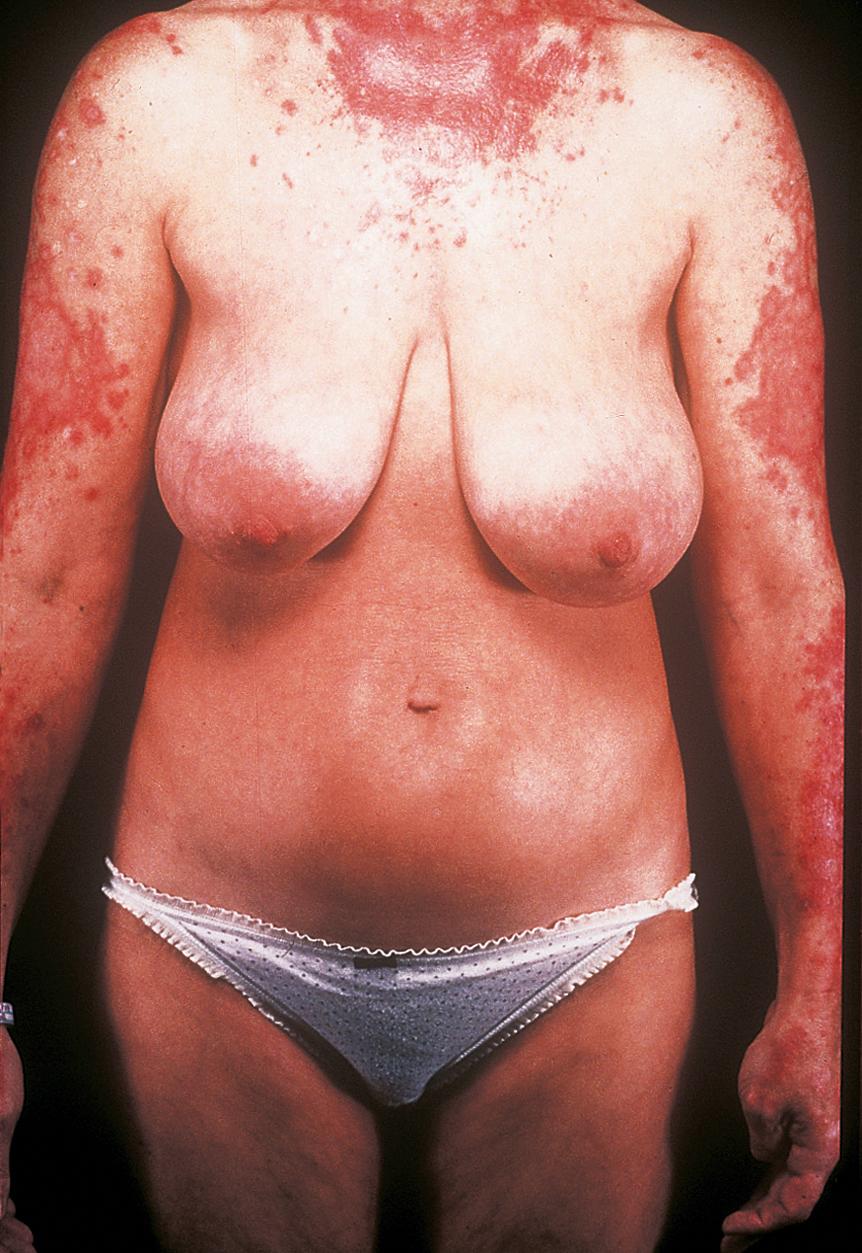
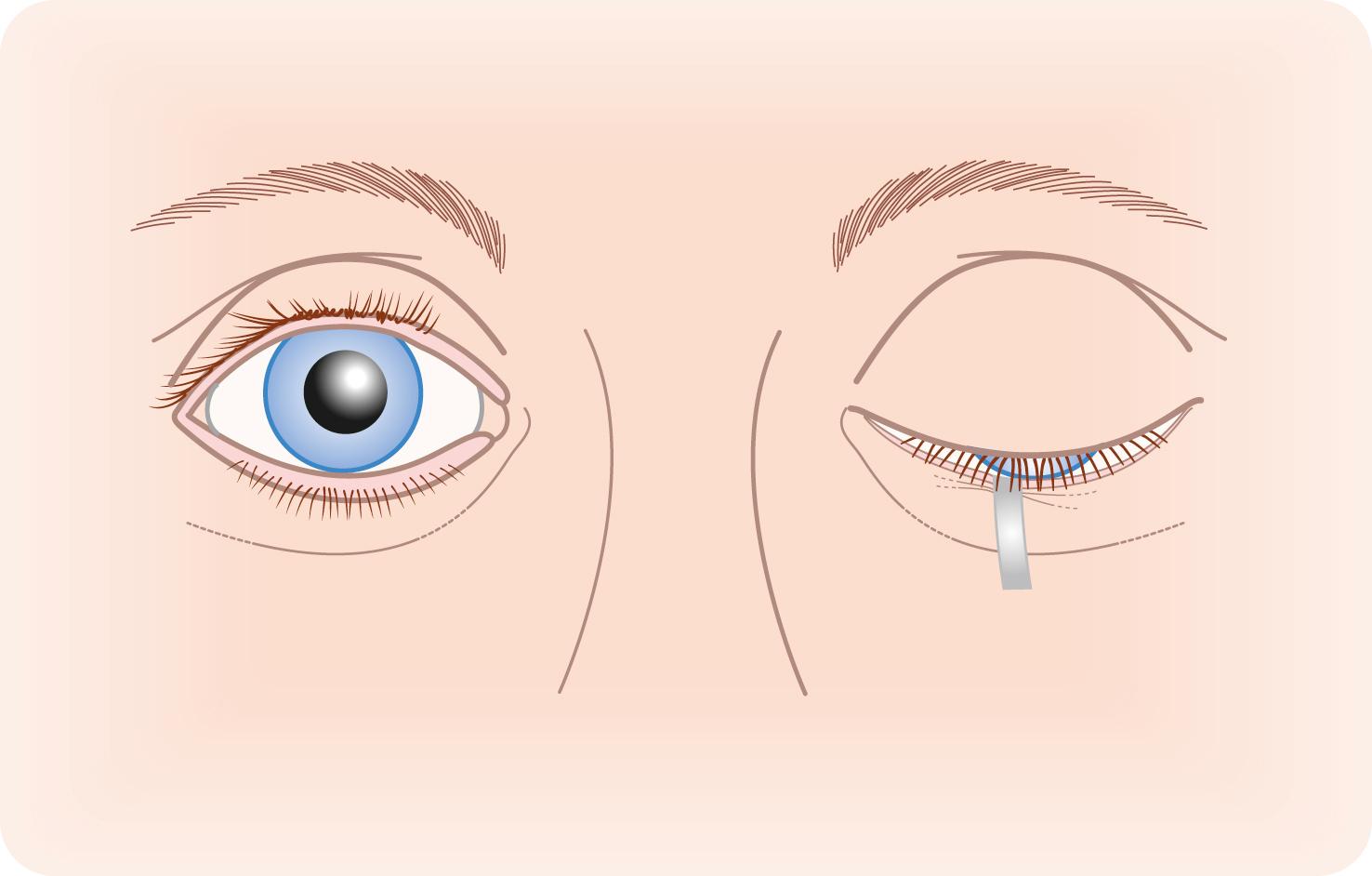
Soft tissue problems, which are common, usually consist of pain, a dull ache, tenderness or swelling. In the elderly these symptoms often appear spontaneously, but in younger people there is usually a history of injury or overuse, through either occupation (e.g. tenosynovitis of the long flexor tendons of the hand) or sport (e.g. Achilles tendinitis in runners, shoulder rotator cuff tendinopathy in swimmers or throwers). It is important to define the exact site of the symptoms and the factors that either make them worse or induce relief. The mechanism of injury is also important and can help guide a focused examination. The localization of symptoms to specific soft tissue structures can be confirmed by careful examination ( Box 15.7 ). The possible structures involved are joint, tendon, ligament, bursa and muscle. Local palpation may be enough to locate bursitis or enthesitis (inflammation at the attachment of a ligament or tendon to bone) accurately. A careful examination may reveal that the complaint and symptoms do not arise from joint pathology, but from soft tissue tendon or ligament structure next to the joint. This often changes the differential diagnosis. Movement of the joint region often elicits pain or discomfort in a particular direction, which can direct the clinician to the affected structure. Subacromial bursitis typically produces pain when the shoulder is abducted to 80° and resolves at 130° to 140°, described as a painful arc, whereas anterior and posterior movements are maintained.
Diffuse pain and tenderness
Generalized joint swelling
Restriction of movement, usually in all directions of movement (specific to each joint)
Localized pain/tenderness at attachment (enthesis) or in the tendon substance
Swelling, tendon sheath or paratendon
Pain on resisted movement
Sometimes pain on stretch (e.g. Achilles)
Become a Clinical Tree membership for Full access and enjoy Unlimited articles
If you are a member. Log in here